 A beautiful day, the sea in front of the Terrazza Mascagni.
A beautiful day, the sea in front of the Terrazza Mascagni.See also: Terrazza Mascagni
 In “Villa Fabbricotti”, a local park, this is the normal condition of the benches after heavy rains. The seat is almost dry, but absolutely beyond reach of any human without waterproof rubber boots.
In “Villa Fabbricotti”, a local park, this is the normal condition of the benches after heavy rains. The seat is almost dry, but absolutely beyond reach of any human without waterproof rubber boots.
 Rome, Naples, Bologna, Florence: all of them have a Fountain of Neptune, so a wealthy and enterprising Livornese decided that we had to have one too. Built in 1934, the fountain was then placed in a square now named after Giuseppe Emanuele Modigliani, the serious brother of the bohémien painter Amedeo.
Rome, Naples, Bologna, Florence: all of them have a Fountain of Neptune, so a wealthy and enterprising Livornese decided that we had to have one too. Built in 1934, the fountain was then placed in a square now named after Giuseppe Emanuele Modigliani, the serious brother of the bohémien painter Amedeo.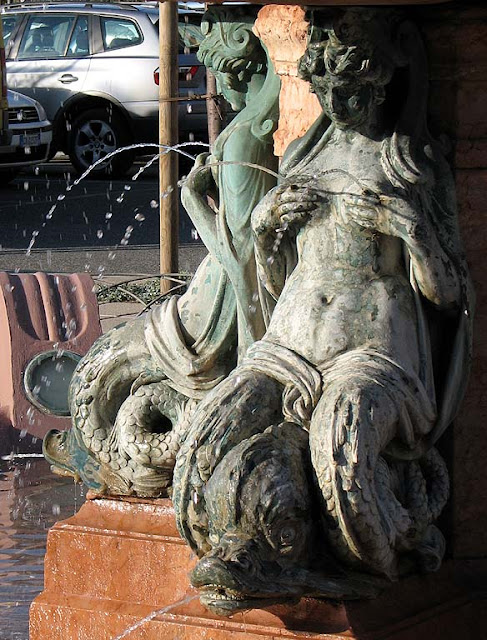 The King of the Sea brandishes his trident, a quartet of lactating Nereids keeps him company along with a posse of various kinds of fishes, all of them happily sprinkling water around.
The King of the Sea brandishes his trident, a quartet of lactating Nereids keeps him company along with a posse of various kinds of fishes, all of them happily sprinkling water around. This beautiful window faces a square officially named “Piazza della Vittoria” (Victory Square). Anyway, if you ever come to Livorno, don't ask for it because, after 80 years, everybody still call it with its old name: “Piazza Magenta”.
This beautiful window faces a square officially named “Piazza della Vittoria” (Victory Square). Anyway, if you ever come to Livorno, don't ask for it because, after 80 years, everybody still call it with its old name: “Piazza Magenta”.
 Three lamp posts and and the “fanale” few days ago, when the weather was better...
Three lamp posts and and the “fanale” few days ago, when the weather was better... A newspaper billboard is called in italian “civetta”, which is literally little owl, but also means coquette, flirt or tease. So these devices are commonly referred as "civette" because their purpose is to entice the passer-by into buying the actual paper.
A newspaper billboard is called in italian “civetta”, which is literally little owl, but also means coquette, flirt or tease. So these devices are commonly referred as "civette" because their purpose is to entice the passer-by into buying the actual paper. The majestic building of the “Camera di Commercio” (Chamber of Commerce) was built in 1648 as a Customs House by Annibale Cecchi of Pistoia. It faces what is now “Piazza del Municipio” (Town Hall Square) and has an imposing portico, with three arches supported by rusticated sandstone pillars, closed by iron gates.
The majestic building of the “Camera di Commercio” (Chamber of Commerce) was built in 1648 as a Customs House by Annibale Cecchi of Pistoia. It faces what is now “Piazza del Municipio” (Town Hall Square) and has an imposing portico, with three arches supported by rusticated sandstone pillars, closed by iron gates. If you compare the above photo with the same building in this print by the painter Giuseppe Maria Terreni (Livorno, 1739-1811), dating back to circa 1785, you can see no major differences after so many years.
If you compare the above photo with the same building in this print by the painter Giuseppe Maria Terreni (Livorno, 1739-1811), dating back to circa 1785, you can see no major differences after so many years.
 The gate of a beautiful villa on “Via Montebello”. This street follows the path of the so called Lorraine or Leopoldine city walls, built in 1835 by the Grand Duke of Tuscany Leopold II and demolished in 1888.
The gate of a beautiful villa on “Via Montebello”. This street follows the path of the so called Lorraine or Leopoldine city walls, built in 1835 by the Grand Duke of Tuscany Leopold II and demolished in 1888.
 All the transportation I need to go to work are my shoes. During this short walk to the office I pass near several things of interest and, by the way, I can also have a look at a Chimera. About this mythological creature Wikipedia says:
All the transportation I need to go to work are my shoes. During this short walk to the office I pass near several things of interest and, by the way, I can also have a look at a Chimera. About this mythological creature Wikipedia says: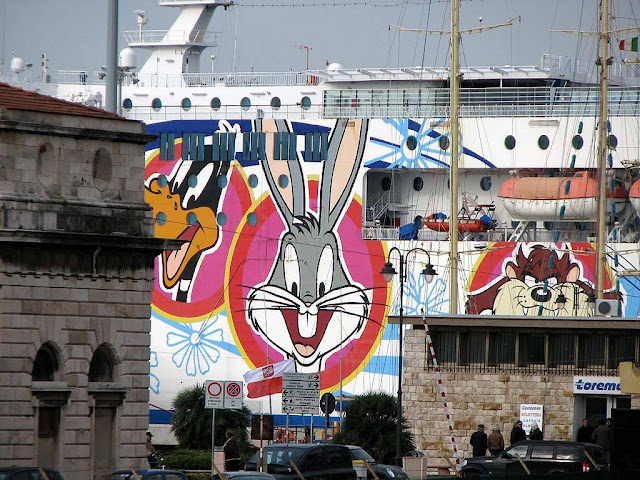 The fast cruiseferry “Moby Aki” in the “Porto Mediceo”. As usual Moby Lines ferries sport funny Looney Tunes liveries. A cruiseferry is a ship that combines the features of a cruise ship with a ferry. Many passengers travel with the ships for the cruise experience, staying only a few hours at the destination port or not leaving the ship at all, while others use the ships as means of transportation. Please note the odd Polish flag waving just in front of Bugs Bunny.
The fast cruiseferry “Moby Aki” in the “Porto Mediceo”. As usual Moby Lines ferries sport funny Looney Tunes liveries. A cruiseferry is a ship that combines the features of a cruise ship with a ferry. Many passengers travel with the ships for the cruise experience, staying only a few hours at the destination port or not leaving the ship at all, while others use the ships as means of transportation. Please note the odd Polish flag waving just in front of Bugs Bunny.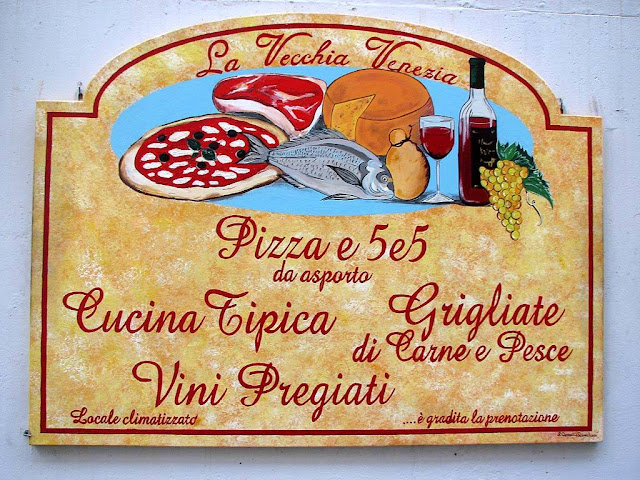
 Ming was close to the truth: a five & five is a sandwich which, long time before the Euro, was just 5 cents (old italian lira) of bread and 5 cents of “torta”.
Ming was close to the truth: a five & five is a sandwich which, long time before the Euro, was just 5 cents (old italian lira) of bread and 5 cents of “torta”. Last year Livorno changed its coat of arms and swapped its traditional gems crown for a mural crown with eight turrets (five visibles).
Last year Livorno changed its coat of arms and swapped its traditional gems crown for a mural crown with eight turrets (five visibles). The municipality spent some time, and probably some money, on this quest for heraldic certainty, with the help of a few consultants and an exchange of letters between Livorno and Rome.
The municipality spent some time, and probably some money, on this quest for heraldic certainty, with the help of a few consultants and an exchange of letters between Livorno and Rome. The “Fanale dei Pisani” (literally Pisans' beacon) is the main lighthouse of the port of Livorno. It is an imposing structure 52 meter tall and, obviously, here is simply called “fanale”. The Repubblica di Pisa, which in the 13th century was interested in the hamlet of Livorno and its harbour, built the tower around 1305 on the south of the entrance to the port. They needed to replace the lighthouse on the Meloria islet, destroyed by the Genoeses in the naval battle of 1284.
The “Fanale dei Pisani” (literally Pisans' beacon) is the main lighthouse of the port of Livorno. It is an imposing structure 52 meter tall and, obviously, here is simply called “fanale”. The Repubblica di Pisa, which in the 13th century was interested in the hamlet of Livorno and its harbour, built the tower around 1305 on the south of the entrance to the port. They needed to replace the lighthouse on the Meloria islet, destroyed by the Genoeses in the naval battle of 1284. Giovanni Fattori, born in Livorno in 1825, was one of the leaders of the Macchiaioli group of painters, the Tuscan forerunners of the Impressionists. In Largo del Cisternino his statue is looking quite puzzled at the shop sign, which says: “Peperoncino. Lusso no grazie! Solo stile e buon gusto” (Chili pepper. Luxury no thank you! style and taste only).
Giovanni Fattori, born in Livorno in 1825, was one of the leaders of the Macchiaioli group of painters, the Tuscan forerunners of the Impressionists. In Largo del Cisternino his statue is looking quite puzzled at the shop sign, which says: “Peperoncino. Lusso no grazie! Solo stile e buon gusto” (Chili pepper. Luxury no thank you! style and taste only). Destroyed during the Second World War, the Gazebo has been rebuilt in 1998 on the same site and almost as an exact replica of the original, as you can see from the period postcard.
Destroyed during the Second World War, the Gazebo has been rebuilt in 1998 on the same site and almost as an exact replica of the original, as you can see from the period postcard. The first Gazebo was built in 1935 by the architect Ghino Venturi at the south end of the “Terrazza Mascagni” (then Terrazza Ciano). The construction, shaped as a round temple, was intended as a bandstand.
The first Gazebo was built in 1935 by the architect Ghino Venturi at the south end of the “Terrazza Mascagni” (then Terrazza Ciano). The construction, shaped as a round temple, was intended as a bandstand.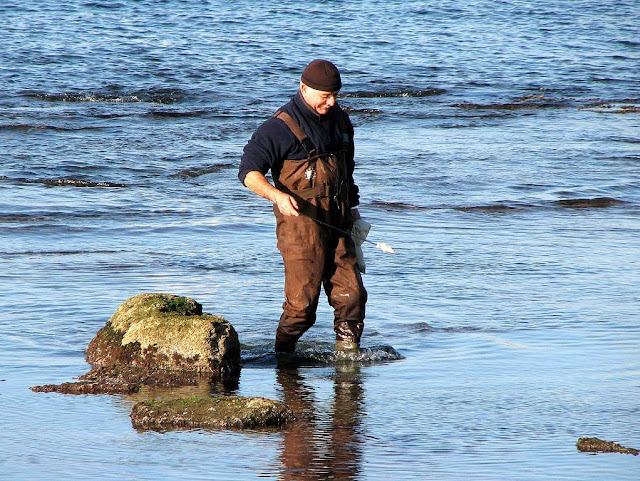 It's a sunny but cold day in January and this man in waterproof gear is tirelessly wading through the shallow waters in front of the Terrazza Mascagni. He is fishing for crabs of a kind called favollo (warty crab), enticing the crustaceans out of their hidings with some bait at the end of a rod and deftly grabbing his prey as soon as it shows up. With care, because the little creatures are mean pinchers with their powerful claws.
It's a sunny but cold day in January and this man in waterproof gear is tirelessly wading through the shallow waters in front of the Terrazza Mascagni. He is fishing for crabs of a kind called favollo (warty crab), enticing the crustaceans out of their hidings with some bait at the end of a rod and deftly grabbing his prey as soon as it shows up. With care, because the little creatures are mean pinchers with their powerful claws.
 The “Terrazza Mascagni” is an elegant promenade by the sea with a wonderful view over the Tyrrhenian sea and the islands of the Tuscan Archipelago. It was built in the 1920's and named “Terrazza Ciano” after Costanzo Ciano, the local fascist leader and father of Galeazzo Ciano, who in 1930 married Mussolini's daughter Edda.
The “Terrazza Mascagni” is an elegant promenade by the sea with a wonderful view over the Tyrrhenian sea and the islands of the Tuscan Archipelago. It was built in the 1920's and named “Terrazza Ciano” after Costanzo Ciano, the local fascist leader and father of Galeazzo Ciano, who in 1930 married Mussolini's daughter Edda. This shop in “Via Palestro” has probably the most colourful roller shutter door in town. The sign says: fruit and vegetables, Mimmo's, pet food. In the rest of Italy you will probably read “cibo” instead of "mangiare" which is not wrong, but a little too vernacular.
This shop in “Via Palestro” has probably the most colourful roller shutter door in town. The sign says: fruit and vegetables, Mimmo's, pet food. In the rest of Italy you will probably read “cibo” instead of "mangiare" which is not wrong, but a little too vernacular.

 This is the oldest and most popular monument in Livorno, celebrating a victory of the Medici over the pirates who roamed the Mediterranean.
This is the oldest and most popular monument in Livorno, celebrating a victory of the Medici over the pirates who roamed the Mediterranean. The statue of Ferdinando I was sculpted in Carrara marble by the florentine Giovanni Bandini in 1595 but placed on its plinth only in 1617, under the rule of his son Cosimo II.
The statue of Ferdinando I was sculpted in Carrara marble by the florentine Giovanni Bandini in 1595 but placed on its plinth only in 1617, under the rule of his son Cosimo II. The “Quattro Mori” (Four Moors), by Pietro Tacca from Carrara, were added later, in couples, between 1623 and 1626. The artist used two real prisoners as models, rewarded with freedom at the end of the pose.
The “Quattro Mori” (Four Moors), by Pietro Tacca from Carrara, were added later, in couples, between 1623 and 1626. The artist used two real prisoners as models, rewarded with freedom at the end of the pose. To make way for a new road, in 1861 the monument was moved back 20 meters to its present position facing the Darsena (the oldest part of the port).
To make way for a new road, in 1861 the monument was moved back 20 meters to its present position facing the Darsena (the oldest part of the port). During the last war the statues were transported for safekeeping to the countryside, to protect them from the Allied air raids.
During the last war the statues were transported for safekeeping to the countryside, to protect them from the Allied air raids.
 Walking around the “Porto Mediceo” we found this colorful boat: it seems to be straight out of a cartoon!
Walking around the “Porto Mediceo” we found this colorful boat: it seems to be straight out of a cartoon!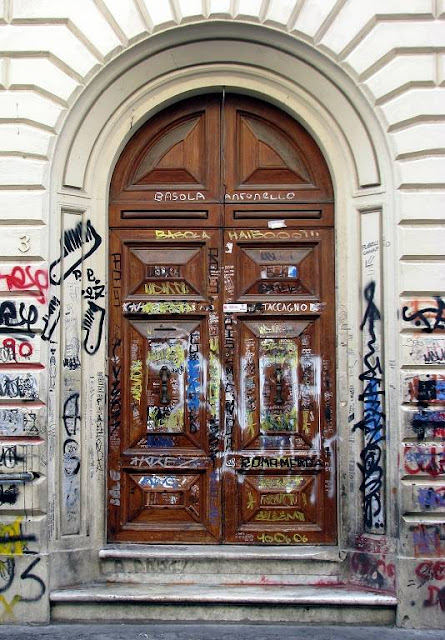 This is not our typical front door, they (the barbarians) usually write and draw on walls everywhere, but still have some respect for doors. More similar masterpieces will be posted...
This is not our typical front door, they (the barbarians) usually write and draw on walls everywhere, but still have some respect for doors. More similar masterpieces will be posted...
 In a previous post I wrote about the now demolished birthplace of Pietro Mascagni. This is the original plaque, now placed on the the new building.
In a previous post I wrote about the now demolished birthplace of Pietro Mascagni. This is the original plaque, now placed on the the new building. A detail of the ferry Moby Love moored in a storm of kisses at the “Porto Mediceo” (port of the Medici). Moby Lines ships have funny liveries usually painted with Looney Tunes characters but in this case the author is the famous cartoonist Mordillo. These ferries serve routes to Olbia (Sardinia) the whole year and to Bastia (Corsica) april to september.
A detail of the ferry Moby Love moored in a storm of kisses at the “Porto Mediceo” (port of the Medici). Moby Lines ships have funny liveries usually painted with Looney Tunes characters but in this case the author is the famous cartoonist Mordillo. These ferries serve routes to Olbia (Sardinia) the whole year and to Bastia (Corsica) april to september. The “Cisternone” (large cistern) is the largest of the three cisterns of Livorno: it was built between 1829 and 1842 on a project by the architect Pasquale Poccianti (1774-1858). The building appears quite unusual in its design, due to the open dome which resembles a cut-away architectural model, appearing as a half-dome or “semi-cupola”.
The “Cisternone” (large cistern) is the largest of the three cisterns of Livorno: it was built between 1829 and 1842 on a project by the architect Pasquale Poccianti (1774-1858). The building appears quite unusual in its design, due to the open dome which resembles a cut-away architectural model, appearing as a half-dome or “semi-cupola”. This cistern was (and still is) used for water storage and treatment before distribution. A later removal of the gravel filtering system enhanced its maximum capacity up to 2.6 million gallons of water (10.000 cubic metres).
This cistern was (and still is) used for water storage and treatment before distribution. A later removal of the gravel filtering system enhanced its maximum capacity up to 2.6 million gallons of water (10.000 cubic metres). The “Cisternone” was also considered as an inspiration for several half-dome bandshells, such as the famous Naumburg Bandshell in Central Park, New York, designed by William G. Tachau in 1916.
The “Cisternone” was also considered as an inspiration for several half-dome bandshells, such as the famous Naumburg Bandshell in Central Park, New York, designed by William G. Tachau in 1916. A patrol boat of the Italian Penitentiary Police exiting the harbor, probably directed to the penal colony of Gorgona, an island in the Tuscan Archipelago about 37 km west of Livorno.
A patrol boat of the Italian Penitentiary Police exiting the harbor, probably directed to the penal colony of Gorgona, an island in the Tuscan Archipelago about 37 km west of Livorno. Gorgona is still an administrative division of the municipality of Livorno, but access to the island for not residents is allowed only with the permission of the Italian Justice Department.
Gorgona is still an administrative division of the municipality of Livorno, but access to the island for not residents is allowed only with the permission of the Italian Justice Department. Wilhelm Oberdank, who italianicized his name to Guglielmo Oberdan, was an Italian irredentist executed in 1882 after a failed assassination attempt on the Emperor Franz Joseph of Austria.
Wilhelm Oberdank, who italianicized his name to Guglielmo Oberdan, was an Italian irredentist executed in 1882 after a failed assassination attempt on the Emperor Franz Joseph of Austria. As you can see, after the igloos, we are trying kayaks along our canals. I am still checking about dog sleds... Who knows?
As you can see, after the igloos, we are trying kayaks along our canals. I am still checking about dog sleds... Who knows?